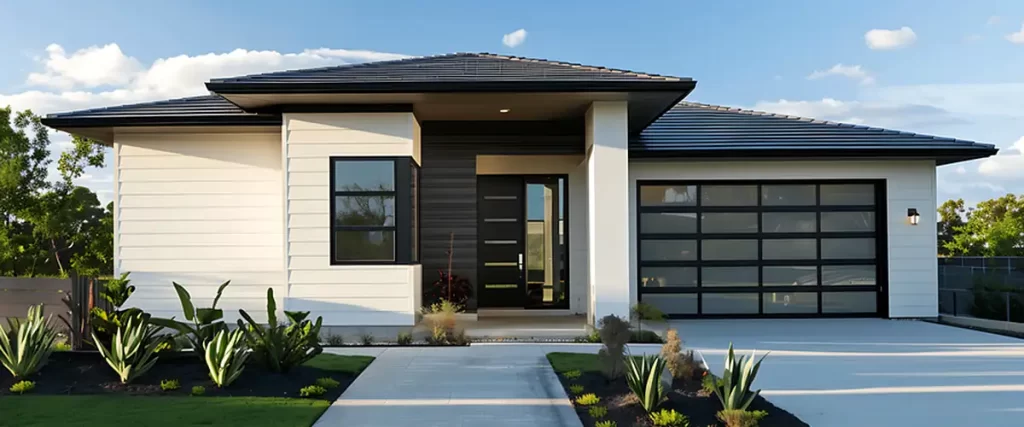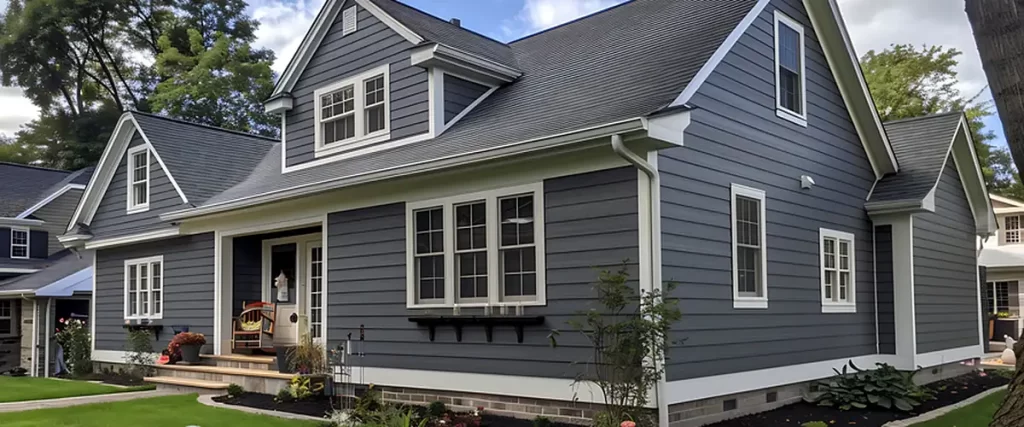Board and batten siding has long been admired for its clean vertical lines and farmhouse charm. With its rise in popularity across both modern and traditional homes, many homeowners are turning to James Hardie board and batten siding for its durability, low maintenance, and attractive style.
Made from fiber cement, this siding is engineered to last, even in climates with high winds, freezing temperatures, and strong sun exposure, conditions that Omaha homeowners are all too familiar with.
Here’s a breakdown of what makes this product stand out, what it typically costs, and how it compares to other siding options available today.

What Is James Hardie Board and Batten Siding?
Board and batten is a vertical siding style where wide boards are installed side by side and narrow battens are placed over the seams. It creates a strong visual pattern and adds dimension to exterior walls. It’s often used on entire homes or as an accent on gables, dormers, or entryways.
James Hardie’s version of board and batten siding is built with fiber cement, combining cement, cellulose fibers, sand, and water to create a long-lasting material that resists moisture and wear.
This style is typically installed using HardiePanel® vertical siding as the base, paired with HardieTrim® battens for the overlay. Together, they replicate the traditional board and batten look while offering modern performance.
Why Homeowners Choose It
Timeless Design
Board and batten works across a wide range of house styles. Whether you’re looking to modernize a craftsman home or add contrast to a traditional ranch, this layout gives a home a bold yet clean appearance.
Strong Performance
James Hardie fiber cement products are built to last. They resist damage from hail, pests, and extreme temperature shifts. Unlike vinyl, the material doesn’t warp or crack in heat or cold. Unlike engineered wood, it won’t swell or decay from moisture.
Low Maintenance
Once installed, the siding requires minimal upkeep. James Hardie’s ColorPlus® Technology finish resists fading and doesn’t need frequent repainting. Occasional washing is enough to keep it looking sharp.
Product Details
HardiePanel® Vertical Siding
This panel serves as the base of the board and batten design. It’s available in several textures:
- Select Cedarmill® – has a soft wood grain appearance
- Smooth – flat and clean, good for a modern look
- Stucco – provides a plaster-like finish
- Sierra 8 – combines vertical lines with a wood-grain look
Each panel comes in 4′ widths and various lengths, usually 8′, 9′, or 10′, depending on wall height.
HardieTrim® Battens
The battens are applied over the panel seams to complete the look. These narrow strips of trim come in multiple widths and can be installed closer together for a denser pattern or further apart for a more open feel. Their thickness matches the panels for a seamless appearance.
Cost of James Hardie Board and Batten Siding
Material Costs
The material portion of the project typically runs between $2.50 and $5.00 per square foot, depending on the product line, finish, and availability. Trim pieces, fasteners, and weather barriers add to that total.
Battens themselves are priced by the linear foot, and the number needed will vary based on spacing preferences and wall layout.
Installation Costs
Installing vertical siding with battens takes more precision and time than horizontal lap siding. On average, total installed cost ranges between $10 and $15 per square foot, with some projects falling slightly below or above that range depending on size and complexity.
Homes with more corners, varying elevations, or unique architectural details typically see higher labor costs due to the additional cuts and alignment needed.
Full Project Example
For a home with 2,000 square feet of exterior wall area, a full board and batten installation might cost between $20,000 and $30,000, inclusive of materials, labor, trim, and underlayment.
Other variables include:
- Removing existing siding
- Repairing sheathing
- Permit requirements
- Specialty tools or scaffolding for high walls
How It Compares to Other Siding Options
Vinyl Board and Batten
Vinyl siding is usually the most affordable option. It installs quickly and costs less per square foot, often landing around $6 to $10 installed. However, vinyl is more prone to cracking, fading, and warping especially with Omaha’s seasonal temperature swings.
James Hardie siding holds up better under heat and cold. It also has a more solid feel and closer visual match to wood.
Engineered Wood Siding
Engineered wood mimics the look of traditional wood but is made with composite materials for better durability. It’s more impact-resistant than vinyl and lighter than fiber cement. Installation costs are similar to Hardie board, but the material may not last as long in wet conditions.
James hardie fiber cement stands out for its fire resistance and long-term durability. It also doesn’t expand and contract as much as wood-based products.
Traditional Wood Siding
While nothing compares to the look of real wood, the maintenance requirements are high. Wood must be painted or stained regularly to protect against rot and insects. It also tends to be more expensive over time due to frequent upkeep and earlier replacement.
Customization and Color Options
James Hardie siding are available prefinished with ColorPlus® Technology, offering baked-on color that resists chipping and fading. Dozens of shades are available, from crisp whites to deep blues and modern neutrals.
If you prefer to paint on-site, unprimed panels are also available. This route allows for more custom tones but adds time and cost to the project.
In addition to color, texture choices allow you to align the siding with your home’s architectural style. You can keep things sleek and smooth or go with a more rustic grain.
Is James Hardie Board and Batten Right for You?
This siding style works well if you’re aiming to give your home a defined, vertical visual with strong lines and depth. It’s a great fit for both full-home coverage and accent sections. When installed with care, it adds both protection and personality.
Homeowners who select this option are often looking for:
- A more durable alternative to vinyl
- Better long-term value with less maintenance
- A siding style that stands out but remains clean and timeless
- A product with resistance to fire, moisture, pests, and temperature changes

Or Maybe You’d Rather Let Us Handle It
There’s a lot involved in getting this style just right. Choosing the right panel and trim size, calculating spacing, figuring out batten layout, and handling precise cuts takes time, tools, and skill. When you add in the removal of old siding, permit requirements, and cleanup, the scope can feel bigger than expected.
We do siding installation for homeowners across the Omaha area, and we’ve worked with homes of all sizes and shapes. If you’d like help selecting the right materials or want it installed by a team that’s done it many times before, we’d be glad to talk.
Call us at (402) 651-1493 or Contact us to schedule a conversation. Our siding contractor will help you decide what works best for your home and get it done with the detail and care it deserves.
